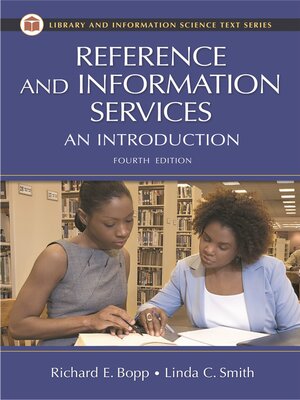Reference and Information Services
ebook ∣ An Introduction · Library and Information Science Text Series
By Richard E. Bopp

Sign up to save your library
With an OverDrive account, you can save your favorite libraries for at-a-glance information about availability. Find out more about OverDrive accounts.
Find this title in Libby, the library reading app by OverDrive.



Search for a digital library with this title
Title found at these libraries:
| Library Name | Distance |
|---|---|
| Loading... |
Reflecting the dramatic changes shaped by rapidly developing technologies over the past six years, this new fourth edition of Reference and Information Services takes the introduction to reference sources and services significantly beyond the content of the first three editions. In Part I, Concepts and Processes, chapters have been revised and updated to reflect new ideas and methods in the provision of reference service in an era when many users have access to the Web. In Part II, Information Sources and Their Use, discussion of each source type has been updated to encompass key resources in print and on the Web, where an increasing number of freely available sources join those purchased or licensed by libraries.
A number of new authors are contributors to this new edition, bringing to their chapters their experience as teachers of reference and as practitioners in different types of libraries. Discussions of services in Part I integrate digital reference as appropriate to each topic, such as how to conduct a reference interview online using instant messaging. Boxes interspersed in the text are used to present scenarios for discussion, to highlight key concepts, or to present excerpts from important documents. Discussions of sources in Part II place more emphasis on designing effective search strategies using both print and digital resources. The chapter on selection and evaluation of sources addresses the changing nature of reference collections and how to evaluate new types of sources. Each chapter concludes with an updated list of additional readings to guide further study.
A new companion website will provide links to Web-accessible readings and resources as well as additional scenarios for discussion and example search strategies to supplement those presented in the text.
A number of new authors are contributors to this new edition, bringing to their chapters their experience as teachers of reference and as practitioners in different types of libraries. Discussions of services in Part I integrate digital reference as appropriate to each topic, such as how to conduct a reference interview online using instant messaging. Boxes interspersed in the text are used to present scenarios for discussion, to highlight key concepts, or to present excerpts from important documents. Discussions of sources in Part II place more emphasis on designing effective search strategies using both print and digital resources. The chapter on selection and evaluation of sources addresses the changing nature of reference collections and how to evaluate new types of sources. Each chapter concludes with an updated list of additional readings to guide further study.
A new companion website will provide links to Web-accessible readings and resources as well as additional scenarios for discussion and example search strategies to supplement those presented in the text.







